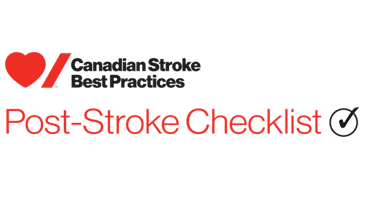- Definitions
- 1. Stroke Awareness, Recognition, and Response
- 2. Triage and Initial Diagnostic Evaluation of Transient Ischemic Attack and Non-Disabling Stroke
- 3. Emergency Medical Services Management of Acute Stroke Patients
- 4. Emergency Department Evaluation and Management of Patients with Acute Stroke and TIA
- 5. Acute Ischemic Stroke Treatment
- 6. Acute Antithrombotic Therapy
- 7. Early Management of Patients Considered for Hemicraniectomy
- 8. Acute Stroke Unit Care
- 9. Inpatient Prevention and Management of Complications following Stroke
- 10. Advanced Care Planning
- 11. Palliative and End of Life Care
Recommendations and/or Clinical Considerations
6.1 Acute antithrombotic therapy for patients not receiving intravenous thrombolysis
- All patients with acute ischemic stroke or transient ischemic attack (TIA) who are not already on an antiplatelet agent should be treated with at least 160 mg of acetylsalicylic acid (ASA) immediately as a one-time loading dose after brain imaging has excluded intracranial hemorrhage [Strong recommendation; High quality of evidence].
- For patients with delayed swallow screen or potential dysphagia, ASA (81 mg daily) or clopidogrel (75 mg daily) may be administered by enteral tube or ASA (325 mg daily) by rectal suppository [Strong recommendation; Moderate quality of evidence]. Note: ASA and clopidogrel should only be administered orally once dysphagia screening has been performed and indicates an absence of potential dysphagia.
- For endovascular thrombectomy (EVT) patients who did not receive intravenous thrombolysis and with no other contraindications, administration of an antiplatelet agent should not be delayed [Strong recommendation; Moderate quality of evidence].
- For patients with stroke who are discharged directly from the emergency department to the community, antiplatelet therapy should be started prior to discharge [Strong recommendation; Moderate quality of evidence].
6.1.1 Acute antithrombotic therapy for patients receiving IV thrombolysis
- For patients receiving intravenous thrombolysis therapy, antiplatelet therapy should be avoided within the first 24 hours; antiplatelet therapy could then be initiated after brain imaging has excluded secondary hemorrhage [Strong recommendation; Moderate quality of evidence]. Refer to Secondary Prevention of Stroke module Sections 6 and 7 for additional information on antithrombotic therapy and anticoagulation for people with atrial fibrillation beyond the acute period.
6.2 Short-Term Dual Antiplatelet Therapy for Secondary Stroke Prevention
- For patients with an acute high-risk TIA or minor ischemic stroke of non-cardioembolic origin (National Institutes of Health Stroke Scale [NIHSS] 0-3), who are not at high bleeding risk, dual antiplatelet therapy (DAPT) is recommended [Strong recommendation; High quality of evidence].
- Suggested regimens include at least:
- ASA 162 mg loading dose followed by ASA 81 mg daily plus clopidogrel 300-600 mg loading dose followed by clopidogrel 75 mg daily, for 21 days [Strong recommendation; High quality of evidence]
OR - ASA 162 mg load dose followed by ASA 81 mg daily plus ticagrelor 180 mg loading dose followed by ticagrelor 90 mg BID for 30 days [Strong recommendation; Moderate quality of evidence]
Note: The choice of the antiplatelet agent to add to ASA (i.e., clopidogrel or ticagrelor) should be based on individual patient and clinical factors, including the risk of moderate to severe hemorrhage described in the clinical trials. - Use of dual antiplatelet therapy for longer than prescribed, as per 6.2ii/a and 6.2ii/b, following a TIA or minor stroke is not recommended unless there is a specific indication (e.g., arterial stent; symptomatic intracranial artery stenosis), due to an increased risk of bleeding [Strong recommendation; Moderate quality of evidence].
- Patients should be counselled that their dual antiplatelet regimen should be followed by single antiplatelet therapy with either ASA or clopidogrel indefinitely. [Strong recommendation; High quality of evidence].
- Patients not meeting criteria for dual antiplatelet therapy should be initiated on a single antiplatelet agent within 24 hours of symptom onset. Suggested regimens include either:
- ASA 162 mg loading dose followed by 81 mg daily [Strong recommendation; High quality of evidence]
OR - Clopidogrel 300 to 600 mg loading dose followed by 75 mg daily [Strong recommendation; High quality of evidence].
6.3 Anticoagulation for Stroke Prevention
- Patients with TIA who are found to have atrial fibrillation should receive oral anticoagulation instead of antiplatelet therapy [Strong recommendation; High quality of evidence] as soon as possible, and ideally within 24 hours of symptom onset [Strong recommendation; Moderate quality of evidence].
- Patients with stroke who are found to have atrial fibrillation should receive oral anticoagulation instead of antiplatelet therapy [Strong recommendation; High quality of evidence], with timing of initiation at the discretion of the physician based on patient-specific factors including size of infarct [Strong recommendation; Moderate quality of evidence].
Section 6 Clinical Considerations
- Patients who are at a very high risk for TIA or minor ischemic stroke caused by high-grade carotid stenosis who are candidates for urgent carotid endarterectomy or carotid stenting should be reviewed with the surgeon or interventionalist to determine the appropriate timing and selection of antiplatelet agent(s).
- For patients on dual antiplatelet therapy, gastrointestinal protection may be considered for those at higher risk of gastrointestinal bleeding.
- For patients with acute stroke or TIA and non-valvular atrial fibrillation, anticoagulation should be initiated; however, there is a lack of randomized evidence to guide specific timing. According to expert consensus, a general approach to the target timing of initiation of DOAC therapy post-stroke is as follows:
- For patients with a brief TIA and no visible infarct or hemorrhage on imaging, anticoagulation may be started within the first 24 hours post-TIA.
- For patients with a minor clinical stroke/small non-hemorrhagic infarct on imaging, anticoagulation may be started 3 days post-stroke.
- For patients with a moderate clinical stroke/moderate-sized infarct on imaging (without hemorrhage on CT), anticoagulation may be started 6 to 7 days post-stroke.
- For patients with a severe clinical stroke/large-sized infarct on imaging (without hemorrhage on CT), anticoagulation may be started 12 to 14 days post-stroke.
- Antiplatelet therapy may be used prior to initiating anticoagulation.
Refer to CSBPR Secondary Prevention of Stroke module sections 6 and 7 for additional information on management of atrial fibrillation and choice of therapeutic agents. - For patients who experience a stroke while receiving one antiplatelet agent, stroke etiology should be reassessed and addressed, and all other vascular risk factors aggressively managed. Continuing the current antiplatelet agent or switching to a different agent are reasonable options. At the time of writing, evidence is lacking to make more specific recommendations.
- (NEW FOR 2022) Platelet function assays and pharmacogenetic testing may indicate antiplatelet activity and patients with potential clopidogrel resistance; however, the clinical implications for stroke prevention treatment are unclear at the time of writing and publication.
Acetylsalicylic acid (ASA) initiated within the first day following stroke and continued for the next several weeks reduces the risk of early recurrent ischemic stroke and early death. For every 1,000 patients treated with aspirin following stroke, seven recurrent ischemic strokes could be avoided, corresponding to a number needed to treat of 140 (Sandercock et al., 2014; Cochrane Database Syst Rev. 2014; 2014(3):CD000029). Long-term aspirin therapy reduces the risk of ischemic stroke, myocardial infarction, and vascular death. A short course of dual antiplatelet with clopidogrel or ticagrelor can also significantly reduce the risk of recurrent stroke or death with the first month following stroke, with number need to treat of 92 (THALES trial JAMA Neurol. 2020 ;78(2):1–9). In clinical trials of alteplase, antithrombotic drugs (including aspirin) were avoided until after the 24-hour post-thrombolysis scan had excluded intracranial hemorrhage.
To ensure people experiencing a stroke receive timely stroke assessments, interventions and management, interdisciplinary teams need to have the infrastructure and resources required. These may include the following components established at a systems level.
- Development and dissemination of protocols and standing order sets to guide initial management of ischemic stroke and TIA patients.
- Optimization of comprehensive strategies at the local, regional and provincial levels to prevent the recurrence of stroke.
- Stroke prevention awareness and education about secondary prevention for all healthcare providers who manage patients with stroke during the acute phase and after discharge from acute care, including content regarding the heart-brain connection and the importance of integrated care that addresses vascular risk factors in a coordinated manner.
- For patients taking warfarin, access to a dedicated anticoagulant management clinic is associated with better patient outcomes compared to routine medical care post discharge.
- Universal and equitable access to cost-effective medicines for all people in Canada, regardless of ability to pay or geography, through private and/or public drug coverage plans which can help manage atrial fibrillation.
System Indicators:
In development.
Process Indicators:
- Proportion of ischemic stroke or TIA patients who receive acute antiplatelet therapy within the first 48 hours following symptom onset.
- Proportion of patients with ischemic stroke or transient ischemic attack prescribed antiplatelet therapy on discharge from acute care.
Patient-oriented outcome and experience indicators:
- Proportion of people discharged with a minor stroke or TIA who are readmitted within 30 days (or 90 days) with a recurrent stroke or TIA.
Measurement notes
- Time interval measurements should be taken from the time the patient is triaged at the hospital until the time the first dose is administered.
- These indicators now expands to include other antiplatelet medications, such as clopidogrel or ASA combined with extended-release dipyridamole. In cases where another agent is used instead of aspirin in the first 48 hours, this should be noted in the local indicator definition.
- Possible data sources include history and physical, physician’s admission notes, nurses’ admission notes, medication record
Resources and tools listed below that are external to Heart & Stroke and the Canadian Stroke Best Practice Recommendations may be useful resources for stroke care. However, their inclusion is not an actual or implied endorsement by the Canadian Stroke Best Practices writing group. The reader is encouraged to review these resources and tools critically and implement them into practice at their discretion.
Healthcare Provider Information
- Heart & Stroke: Post-Stroke Checklist
- Canadian Cardiovascular Society Antiplatelet Therapy Guidelines
- Thrombosis Canada Clinical Guides
- CHEST Antithrombotic Guidelines
- Canadian Cardiovascular Society Antiplatelet Therapy Guidelines
- Canadian Cardiovascular Society Guideline Resource
- CLOT + is a continuously updated repository of current best evidence from research to support evidence-based clinical decisions
- The Ontario Acute Stroke Best Practice Coordinators and the Ontario Regional Education Group in collaboration with Heart & Stroke: Key Changes to the 2022 Acute Stroke Management Canadian Stroke Best Practice Recommendations
Information for people with lived experience of stroke, including family, friends and caregivers
- Heart & Stroke: Your Stroke Journey
- Heart & Stroke: Post-Stroke Checklist
- Heart & Stroke: Acute Stroke Management Infographic
- Heart & Stroke: Antiplatelets
- Heart & Stroke: Online and Peer Support
- Thrombosis Canada: Patient and Family Information
- Thrombosis Interest Group of Canada ‘Medical Information for Patients taking Antiplatelets (PDF)
Evidence Table and Reference List
Sex and Gender Considerations Reference List
Early antiplatelet therapy provided acutely following ischemic stroke is known to reduce the risk of recurrent ischemic stroke. ASA is arguably the most commonly used agent. Results from two of the largest trials of ASA indicate that treatment can reduce the risk of death and recurrent stroke.
In the Chinese Acute Stroke Trial (CAST, Chen et al., 1997), 21,106 patients with acute stroke onset within the previous 48 hours were randomized to receive 160 mg/day of aspirin or placebo for four weeks during hospitalization. There were significantly fewer deaths among patients in the aspirin group (3.3% vs. 3.9%, absolute benefit 5.4/1,000) and fewer recurrent ischemic strokes (1.6% vs. 2.1%, absolute benefit of 4.7/1,000). Aspirin therapy was associated with an excess of 2.7/1,000 transfused or fatal extracranial bleeds during the treatment period (0.8% vs. 0.6%, p=0.02). In the aspirin arm of the factorial IST (1997) 9,720 patients with a suspected acute ischemic stroke with onset of <48 hours were randomized to receive 300 mg/day of aspirin and a similar number avoided aspirin for 14 days. The median time to randomization was 19 hours, while 20% of patients were randomized within 6 hours of symptom onset. Fourteen-day mortality was non-significantly lower in the aspirin group (9.0% vs. 9.4%). Recurrent ischemic stroke was significantly lower in the aspirin arm (2.8% vs. 3.9%, number needed to treat [NNT] 91), with no significant difference between groups in the frequency of symptomatic intracerebral hemorrhage (0.9% vs. 0.8%). In a recent Cochrane review (Minhas et al. 2022), in which the results of CAST and IST contributed 96% of the data, the odds of the primary outcome (death or dependence at follow-up) were significantly lower in the antiplatelet group (OR=0.95, 95% CI 0.90-0.99), with 13 fewer events/1,000 patients treated, and a number needed to benefit of 79. The odds of recurrent ischemic stroke were also significantly lower without any significantly increased risk of intracerebral hemorrhage.
The results of a retrospective study suggest that an initial loading dose of at least 160 mg ASA is required for therapeutic benefit. Su et al. (2016) examined the outcomes of patients with acute stroke who had received high-dose aspirin (160-325 mg) vs. low-dose aspirin (<160 mg), as a loading dose in the emergency department. Propensity matching (3:1) was used to balance baseline differences between groups. The mean loading doses of aspirin in the groups were high-dose: 211.4 mg and 100.0 mg, respectively. After propensity matching and further adjustment for age and other potential confounders, the odds of a favourable outcome (mRS 0-1) at hospital discharge were increased significantly for patients in the high-dose group (OR=1.54, 95% CI 1.23-1.93). High-dose aspirin was associated with a 20% increased risk of minor bleeding events, but not major bleeding events, with an increase of 10%.
Short-term DAPT with either clopidogrel or ticagrelor is effective in reducing the risk of recurrent ischemic stroke in selected patients. Johnston et al. (2018) enrolled 4,881 patients with recent (within previous 12 hours) minor stroke or TIA from centres located mainly in the United States in the Platelet-Oriented Inhibition in New TIA & Minor Ischemic Stroke (POINT) Trial. Patients were randomized to receive 81 mg aspirin plus 75 mg clopidogrel (following a loading dose of 600 mg) vs. aspirin plus placebo for 90 days. At the end of the trial, significantly fewer patients in the clopidogrel–aspirin group had experienced a new vascular event (5% vs. 6.5%, HR=0.75, 95% CI 0.59–0.95), or ischemic stroke (4.6% vs. 6.3%; HR=0.72, 95% CI 0.56–0.92, p= 0.01); however, the risk of major hemorrhage was significantly increased (0.9% vs. 0.4%, HR=2.32, 95% CI 1.10–4.87, p= 0.02). The authors estimated that for every 1,000 patients treated with clopidogrel plus aspirin for 90 days, 15 ischemic strokes would be prevented but five major hemorrhages would result. The greatest protection from treatment was seen in the first 21 days during which the risk of a major ischemic event was significantly lower in the clopidogrel–aspirin group (HR=0.65, 95% CI 0.50–0.85, p=0.0015), but not from 22 to 90 days (HR=1.38, 95% CI 0.81–2.35, p=0.24) (Johnston et al., 2019). Although the antiplatelet regimen in the Clopidogrel in High-Risk Patients with Acute Nondisabling Cerebrovascular Events (CHANCE, Wang et al., 2013) trial was slightly different than the POINT trial, as patients in the DAPT group received an aspirin placebo for days 22 to 90, and the dose was 75 mg daily, the results were similar, whereby significantly fewer patients in the clopidogrel plus aspirin group experienced a stroke within 90 days (8.2% vs. 11.7%, HR=0.68, 95% CI 0.0.57-0.81, p<0.001). The composite outcome of myocardial infarction, stroke, or vascular death stroke was also reduced significantly in the dual antiplatelet group (8.4% vs. 11.9%, HR=0.69, 95% CI 0.58- 0.82, p<0.001), with no significant increased risk of any bleeding events between groups (2.3% vs. 1.6%, p=0.09). The Acute STroke or Transient IscHaemic Attack Treated with TicAgreLor and ASA for PrEvention of Stroke and Death (THALES) trial (Johnston et al., 2020) included 11,0161 patients from 450 sites globally, with minor acute ischemic stroke (NIHSS score of ≤5) or high-risk TIA (ABCD2 score of ≥6) or symptomatic intracranial or extracranial arterial stenosis. Patients were randomized to receive 90 mg ticagrelor twice a day plus 75-100 aspirin mg/day vs. 75-100 mg aspirin daily, within five days of stroke onset, for 30 days. The risk of the primary event (recurrent stroke or death within 30 days) was significantly lower in the ticagrelor–aspirin group (5.5% vs. 6.6%, HR=0.83, 95% CI 0.71-0.96, NNT=92), as was the risk of recurrent stroke (5.0% vs. 6.3%, HR=0.79, 95% CI 0.63-0.94). The risks of severe bleeding and intracranial hemorrhage or fatal bleeding were significantly higher in the ticagrelor–aspirin group (0.5% vs. 0.1%, HR=3.99, 95% CI 1.74–9.14, and 0.4% vs. 0.1%, HR=3.66, 95% CI 1.48–9.02, respectively).
A systematic review, including the results of four trials of DAPT with either clopidogrel (POINT, CHANCE and FASTER [Kennedy et al,. 2007]) or ticagrelor (THALES) found that DAPT significantly reduced the risk of stroke recurrence (RR=0.74, 95% CI 0.67–0.82, absolute risk difference=2%, NNT=50), while increasing the risk of major bleeding compared with aspirin (RR=2.54, 95% CI 1.65 to 3.92, absolute risk difference= 0.4%, NNH=250). Both of these findings were associated with high certainty of evidence (Pomero et al., 2022). The risk of disabling stroke (mRS>2) was also reduced significantly with DAPT (RR=0.84, 95% CI 0.75 to 0.95). In a meta-analysis which pooled the results of the patient-level data from the POINT and CHANCE trials, Pan et al. (2019), reported that the risks of ischemic stroke and disabling or fatal stroke were reduced by 31% in the DAPT group, with no significant increases in major hemorrhage or hemorrhagic stroke. The risk of a major ischemic event associated with DAPT was reduced significantly with treatment provided during days 0 to 21, with the effect being most pronounced during days 1 to 10. There was no significant reduction in events associated with DAPT use from days 22 to 90.
For those who are unable to tolerate DAPT, monotherapy with either ASA or clopidogrel is indicated. In the CAPRIE trial (Gent et al., 1996), 19,185 patients who had experienced an ischemic stroke thought to be of atherothrombotic origin, or myocardial infarction, or had peripheral artery disease, were randomized to receive 75 mg of clopidogrel or 325 mg aspirin daily for one to three years. The mean time from stroke onset to randomization was 53 days. After a mean duration of follow-up of 1.9 years, the risk of the primary outcome (ischemic stroke, myocardial infarction, or vascular death) was significantly lower in the clopidogrel group (event rate/year 5.32% vs. 5.83%, absolute risk reduction=0.51%; relative risk reduction=8.7%, 95% CI 0.3%-16.5%, p=0.043). There were no major differences between groups on any of the bleeding outcomes.
Sex & Gender Considerations
Sex as a potential effect modifier was examined in the analysis of the primary outcome in all of the major trials of DAPT used to inform the current guideline recommendations including POINT, CHANCE, and THALES. In all trials, no differences in outcomes between men vs. women were found in the comparison of the DAPT and monotherapy groups. In the early trials of ASA monotherapy (CAST 1997 and IST 1997), the effect of sex on outcome was not examined in subgroup analysis.





